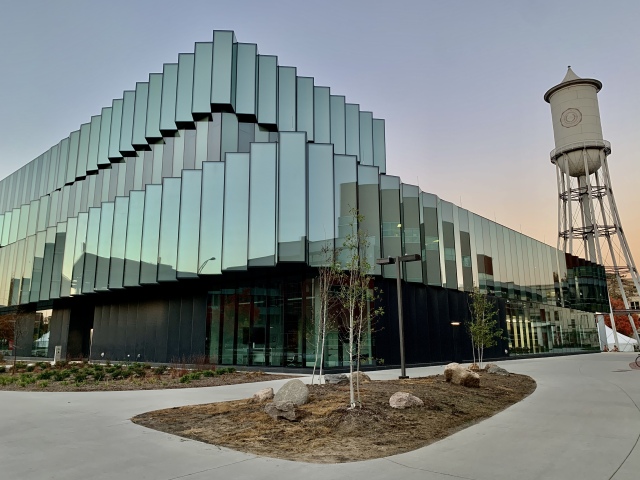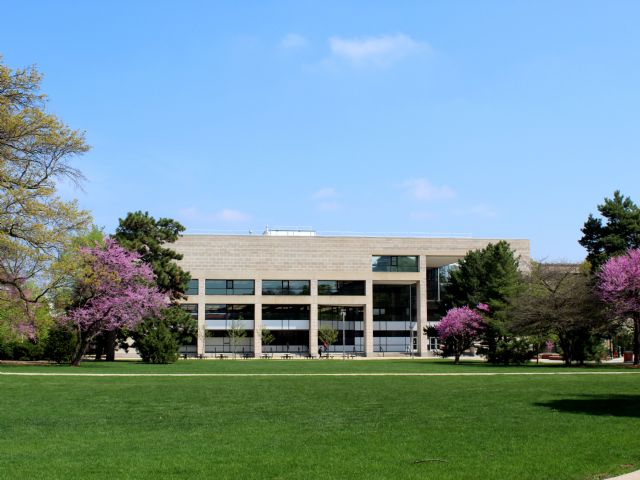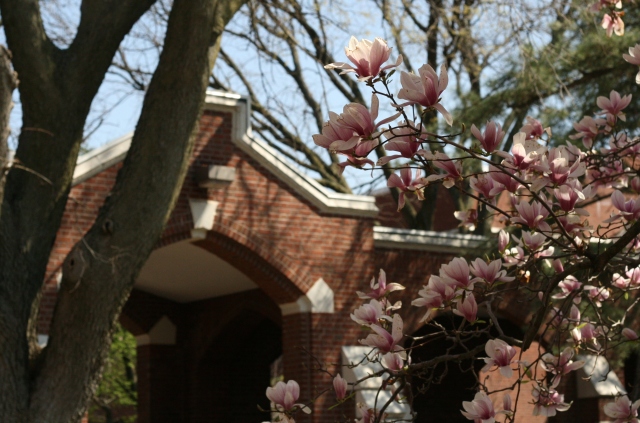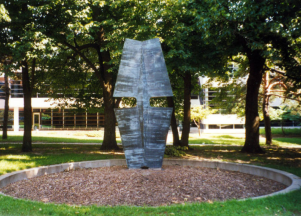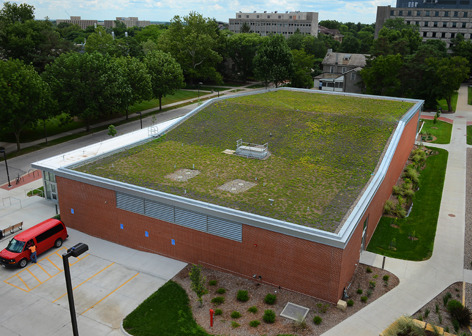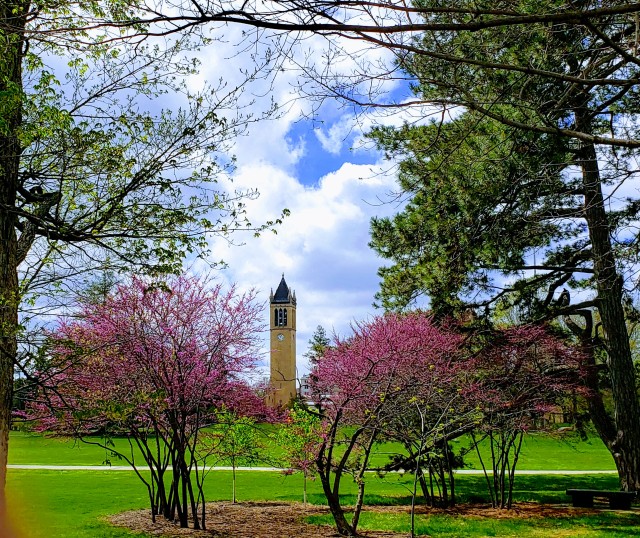Spring - Map and Pause Location Details
Part of the richness of the Strolls for Well-being at ISU is the intentional selection of the pause locations for Spring. Locations were selected to include various natural settings and the amazing art that is part of the ISU campus. The following map includes the specific locations along with the history and/or information about the art that you will find at the pause. Download the map and history.
Now pick a stroll, or a pause, that you would like to explore. Check the history and find it on the map as you set out to enjoy a simple mindfulness practice.
PAUSE 1: Marston Water Tower
Erected in 1897, the Water Tower was built to alleviate the water shortage on the Iowa State campus, which in 1895 had forced classes to cancel for two weeks. Designed by Anson Marston (Dean of Engineering, 1914-1932) and others, the Water Tower was the first elevated steel water tower west of the Mississippi standing 168 feet above campus and holding 162,000 gallons.
In 1978, the use of the Water Tower was discontinued when the university switched to a city water system. The Marston Water Tower was placed on the National Register of Historic Places in 1981 and was restored sixteen years later in 1997.
PAUSE 2: Parks Library
In the Parks Library on central campus,there are two murals designed by Iowan artist Grant Wood in the 1930’s. The first, “When Tillage Begins, Other Arts Follow” reflects the 1840 quote by Daniel Webster, "When tillage begins, other arts follow. The farmers, therefore, are the founders of human civilization." This mural exemplifies the regionalist movement in American art, depicting rural and simple people heroically struggling with nature to produce the nation's harvest.
Wood’s second mural “Breaking the Prairie” portrays the beginning of tillage in Iowa by the pioneers in the 1840s. In both murals, the clothing, farm implements, livestock and prairie flowers are historically and scientifically accurate, yet the overall theme is romanticized through certain stylized images. For instance, the plowed sod appears as plush as carpet and neither human nor animal perspires despite the grueling work of farming the prairie. Decorative touches are included in the scene such as nails in the barn and stitching and buttons in the overalls.
The mural is a tribute to the founding of the land-grant colleges, including Iowa State Agricultural College and Model Farm in 1858. The creation of these colleges during the Civil War is regarded as an indication of Lincoln's faith in the future of the "united" United States.
PAUSE 3: Lagomarcino Courtyard
Lagomarcino Hall, built in 1912, was first known as the 'Quadrangle’ and was home to the College of Veterinary Medicine. In 1978, the College of Veterinary Medicine relocated and the College of Education took up residence. Upon this change, the building was renamed Lagomarcino Hall in honor of the former dean of the College of Education, Virgil Lagomarcino.
The ‘Lago Courtyard’ is used by faculty, staff and students as a place to take a break and enjoy various pieces of art and diverse foliage. One piece of artwork, “Madonna of the Prairie”by artist Christian Peterson, was placed in the courtyard in 1982. In this tribute to pioneer women, a mother holds her small child and both gaze toward the tallgrass prairie, a land which is destined for their homestead. In a northern section of the Lago Courtyard, a hand forged, functional, ornamental steel gate was constructed by the same means that ornamental ironwork would have been done at the turn of the century. These artworks were designed to fit with existing architecture and enhance Lagomarcino Hall.
PAUSE 4: Agronomy Hall Courtyard (Janus Agri Altar)
Did you know the bronze sculpture in the Agronomy Courtyard was created in 1986 by artist Beverly Pepper and is officially called "Janus Agri Altar?"
ISU asked Pepper to create a sculpture that reflects agricultural business. The artist researched antique farm tools common to the area and focused on a farmer’s spade to create the Janus Agri Altar sculpture. Pepper included a reference to Janus, one of the principal Roman gods, which is typically represented with two bearded heads placed back to back so that the Roman god might look in all directions. While representations of the Janus are usually horizontal, she made this altar vertical, like a reflective pool. A place where one refreshes the spirit and looks inside oneself. Pepper wanted to create a peaceful, self-reflective symbol, and the Janus Agri Altar looks inward and focuses outward.
The Agronomy Hall Courtyard is a quiet place for staff, students and campus visitors to study or pause in the tree-filled space.
PAUSE 5: Troxel Hall
Hall is a 400-seat auditorium facility on the east side of campus that was designed as one of the most sustainable buildings on campus when it opened in 2013. Design elements included half of the lecture hall underground so it did not shade the greenhouses to the west. Plantings and white concrete were used to reduce the daylight heat on the site and 65 percent of the roof was planted with vegetation. Rain gardens on the roof also help deal with storm water control, lowering mechanical and electrical costs.
Troxell Hall earned Iowa State another LEED® Gold certification and Iowa State's eighth LEED-certified building The building is named for Alumnus Doug Troxel whose philanthropic organization concentrates on three areas to support: science, the environment and education. The gardens along the building are beautiful and offer a place to pause and smell the flowers.
PAUSE 6: Campanile
The landmark Campanile is located on central campus of ISU. Construction of the Campanile began in July of 1897 and the tower was completed in October of 1898. The Stanton Memorial Carillon originally had ten bells placed in the tower in1899. Bells were added in 1929, 1956 and one final bell in 1967 to reach its current total of 50 bells in the Stanton Memorial Carillion.
Dr. Tin-Shi Tam has been the University Carillonneur since 1994 is only one of five individuals who have held the title of University Carillonneur at ISU since 1931.
There are a number of ISU traditions that include the Campanile. One tradition known as 'campaniling' states that a student officially becomes an Iowa Stater when kissed under the campanile as the carillon tolls midnight. Another long-standing tradition is the annual tree-lighting holiday celebration. At dusk, music from the carillon fills the air as people gather to sing, listen to the President's holiday message and watch a nearby 65-foot Norway spruce come aglow with hundreds of colored lights.
The carillon bells ring daily as a mid-day concert, so find a comfortable place on campus to enjoy the music. The tradition of the bells of Iowa State continues to be strong.
